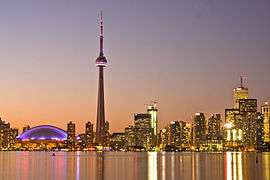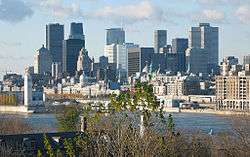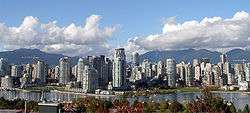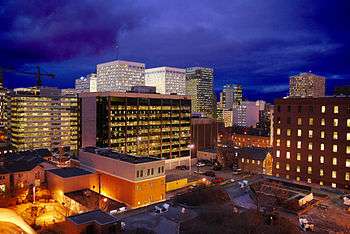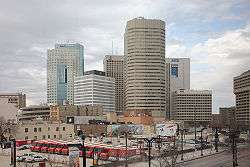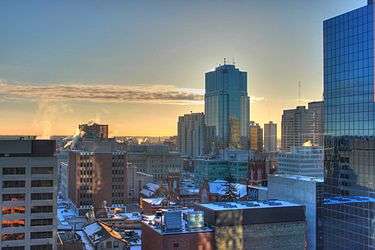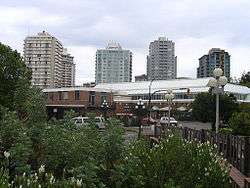List of the 100 largest population centres in Canada
A population centre, in the context of a Canadian census, is a populated place, or a cluster of interrelated populated places, which meets the demographic characteristics of an urban area, having a population of at least 1,000 people and a population density of no fewer than 400 people per square km2.[1]
The term was first introduced in the Canada 2011 Census; prior to that, Statistics Canada used the term urban area.[1]
Statistics Canada listed 942 population centres in its 2011 census data; 513 of them, 54 per cent of all population centres in Canada, were located in Ontario or Quebec, the two most populous provinces.
History
The term "population centre" was chosen in order to better reflect the fact that urban vs. rural is not a strict division, but rather a continuum within which several distinct settlement patterns, and several competing interpretations of the distinction, may exist.[1] For example, a community may fit a strictly statistical definition of an urban area, but may not be commonly thought of as "urban" because it has a smaller population, or because it functions socially and economically as a suburb of another urban area rather than as a self-contained urban entity, or because it is geographically remote from other urban communities.
Accordingly, the new definition set out three distinct types of population centres: small (population 1,000 to 29,999), medium (population 30,000 to 99,999) and large (population 100,000 or greater).[1] Despite the change in terminology, however, the demographic definition of a population centre remains unchanged from that of an urban area: a population of at least 1,000 people where the density is no fewer than 400 persons per square km2.
Characteristics
A population centre does not necessarily correspond to the boundaries of a municipality or of a census division. For example, a less densely populated area within a city's municipal boundaries may not be included as part of its population centre, while neighbouring municipalities that directly continue a city's urban core population will be included.
For example, the population centre of Toronto extends into neighbouring Peel Region, Halton Region, Durham Region and York Region, encompassing places such as Oakville, Mississauga, Brampton, Vaughan, Markham, Richmond Hill, Aurora, Newmarket, Pickering and Ajax. Despite this, numerous other communities which are considered part of the Greater Toronto Area for political purposes are not part of the population centre of Toronto; because a belt of more rural settlement or undeveloped wilderness separates them geographically from the primary band of urban settlement, communities such as Milton, Georgetown, Caledon, Bolton, Nobleton, Bradford and Stouffville instead form their own separate small or medium population centres.[2] However, a population centre does not cross the boundaries of a Census Metropolitan Area; even though the band of continuous urban development emanating outward from downtown Toronto along the shore of Lake Ontario extends even further into Hamilton and Oshawa, these two cities are both considered separate CMAs by Statistics Canada rather than being part of Toronto's, and accordingly each is also considered a distinct population centre.
Conversely, a single municipality may also contain more than one distinct population centre, if less densely populated or undeveloped regions separate more urbanized areas from one another. For example, Ottawa currently has seven distinct population centres (Ottawa-Gatineau, Constance Bay, Kanata, Richmond, Osgoode, Manotick and Metcalfe),[3] the neighbouring city of Gatineau has a secondary population centre at Buckingham in addition to its primary urban core forming part of Ottawa-Gatineau, and Greater Sudbury currently has six distinct population centres (Sudbury, Capreol, Dowling, Lively, Onaping-Levack and Valley East).[4]
For actual "city limits" populations, see List of the 100 largest municipalities in Canada by population, and for metropolitan area populations, see List of metropolitan areas in Canada.
Lists

By population rank
| Rank | Population centre [5] | Population in 2011 [6] | Population in 2006 | Class |
|---|---|---|---|---|
| 1 | Toronto, Ontario | 5,132,794 | 4,732,361 | Large urban |
| 2 | Montreal, Quebec | 3,407,963 | 3,260,508 | Large urban |
| 3 | Vancouver, British Columbia | 2,135,201 | 1,955,278 | Large urban |
| 4 | Calgary, Alberta | 1,095,404 | 988,079 | Large urban |
| 5 | Edmonton, Alberta | 960,015 | 862,544 | Large urban |
| 6 | Ottawa–Gatineau, Ontario/Quebec | 933,596 | 867,593 | Large urban |
| 7 | Quebec City, Quebec | 696,946 | 661,011 | Large urban |
| 8 | Winnipeg, Manitoba | 671,551 | 641,556 | Large urban |
| 9 | Hamilton, Ontario | 670,580 | 647,682 | Large urban |
| 10 | Kitchener, Ontario | 444,681 | 422,514 | Large urban |
| 11 | London, Ontario | 366,191 | 353,874 | Large urban |
| 12 | Victoria, British Columbia | 316,327 | 303,977 | Large urban |
| 13 | St. Catharines–Niagara, Ontario | 309,319 | 308,820 | Large urban |
| 14 | Halifax, Nova Scotia | 297,943 | 285,480 | Large urban |
| 15 | Oshawa, Ontario | 290,937 | 270,059 | Large urban |
| 16 | Windsor, Ontario | 276,165 | 278,869 | Large urban |
| 17 | Saskatoon, Saskatchewan | 222,035 | 202,425 | Large urban |
| 18 | Regina, Saskatchewan | 192,756 | 179,246 | Large urban |
| 19 | Barrie, Ontario | 166,634 | 157,501 | Large urban |
| 20 | St. John's, Newfoundland and Labrador | 165,346 | 152,729 | Large urban |
| 21 | Abbotsford, British Columbia | 149,855 | 140,275 | Large urban |
| 22 | Kelowna, British Columbia | 141,767 | 128,127 | Large urban |
| 23 | Sherbrooke, Quebec | 140,628 | 134,882 | Large urban |
| 24 | Trois-Rivières, Quebec | 126,460 | 121,671 | Large urban |
| 25 | Guelph, Ontario | 122,362 | 115,635 | Large urban |
| 26 | Kingston, Ontario | 117,787 | 112,580 | Large urban |
| 27 | Moncton, New Brunswick | 107,086 | 96,987 | Large urban |
| 28 | Sudbury, Ontario | 106,840 | 106,612 | Large urban |
| 29 | Chicoutimi-Jonquière, Quebec | 106,666 | 106,184 | Large urban |
| 30 | Thunder Bay, Ontario | 102,222 | 103,247 | Large urban |
| 31 | Kanata, Ontario | 101,760 | 86,632 | Large urban |
| 32 | Saint John, New Brunswick | 95,902 | 91,352 | Medium |
| 33 | Brantford, Ontario | 93,650 | 90,192 | Medium |
| 34 | Red Deer, Alberta | 90,207 | 82,732 | Medium |
| 35 | Nanaimo, British Columbia | 88,799 | 84,100 | Medium |
| 36 | Lethbridge, Alberta | 83,679 | 74,870 | Medium |
| 37 | Saint-Jean-sur-Richelieu, Quebec | 83,053 | 78,519 | Medium |
| 38 | White Rock, British Columbia | 82,368 | 74,023 | Medium |
| 39 | Peterborough, Ontario | 80,660 | 77,348 | Medium |
| 40 | Sarnia, Ontario | 79,526 | 78,827 | Medium |
| 41 | Milton, Ontario | 75,573 | 45,486 | Medium |
| 42 | Kamloops, British Columbia | 73,472 | 70,549 | Medium |
| 43 | Châteauguay, Quebec | 70,812 | 66,204 | Medium |
| 44 | Sault Ste. Marie, Ontario | 67,646 | 67,734 | Medium |
| 45 | Chilliwack, British Columbia | 66,382 | 58,593 | Medium |
| 46 | Drummondville, Quebec | 66,314 | 62,199 | Medium |
| 47 | Saint-Jérôme, Quebec | 65,825 | 62,368 | Medium |
| 48 | Medicine Hat, Alberta | 65,671 | 62,203 | Medium |
| 49 | Prince George, British Columbia | 65,503 | 65,066 | Medium |
| 50 | Belleville, Ontario | 63,985 | 64,310 | Medium |
| 51 | Fredericton, New Brunswick | 61,522 | 57,255 | Medium |
| 52 | Fort McMurray, Alberta | 61,374 | 47,705 | Medium |
| 53 | Granby, Quebec | 60,281 | 56,777 | Medium |
| 54 | Grande Prairie, Alberta | 54,913 | 47,066 | Medium |
| 55 | North Bay, Ontario | 53,515 | 53,100 | Medium |
| 56 | Beloeil, Quebec | 50,796 | 46,574 | Medium |
| 57 | Cornwall, Ontario | 49,243 | 48,792 | Medium |
| 58 | Saint-Hyacinthe, Quebec | 48,576 | 47,306 | Medium |
| 59 | Shawinigan, Quebec | 47,735 | 49,236 | Medium |
| 60 | Brandon, Manitoba | 46,061 | 41,511 | Medium |
| 61 | Vernon, British Columbia | 44,600 | 42,731 | Medium |
| 62 | Chatham, Ontario | 44,074 | 45,783 | Medium |
| 63 | Bowmanville-Newcastle, Ontario | 43,555 | 38,265 | Medium |
| 64 | Joliette, Quebec | 42,883 | 39,219 | Medium |
| 65 | Charlottetown, Prince Edward Island | 42,602 | 38,801 | Medium |
| 66 | Airdrie, Alberta | 42,564 | 28,927 | Medium |
| 67 | Victoriaville, Quebec | 41,701 | 38,435 | Medium |
| 68 | St. Thomas, Ontario | 41,688 | 39,573 | Medium |
| 69 | Courtenay, British Columbia | 40,809 | 37,435 | Medium |
| 70 | Georgetown, Ontario | 40,150 | 36,755 | Medium |
| 71 | Salaberry-de-Valleyfield, Quebec | 39,391 | 38,936 | Medium |
| 72 | Rimouski, Quebec | 37,664 | 35,948 | Medium |
| 73 | Woodstock, Ontario | 37,362 | 35,424 | Medium |
| 74 | Sorel-Tracy, Quebec | 36,969 | 36,594 | Medium |
| 75 | Penticton, British Columbia | 36,902 | 35,846 | Medium |
| 76 | Prince Albert, Saskatchewan | 35,552 | 34,547 | Medium |
| 77 | Campbell River, British Columbia | 34,514 | 33,121 | Medium |
| 78 | Moose Jaw, Saskatchewan | 33,617 | 32,526 | Medium |
| 79 | Cape Breton-Sydney, Nova Scotia | 31,597 | 32,496 | Medium |
| 80 | Midland, Ontario | 31,428 | 31,312 | Medium |
| 81 | Leamington, Ontario | 31,254 | 31,113 | Medium |
| 82 | Stratford, Ontario | 30,886 | 30,516 | Medium |
| 83 | Orangeville, Ontario | 30,729 | 29,110 | Medium |
| 84 | Timmins, Ontario | 30,614 | 30,253 | Medium |
| 85 | Orillia, Ontario | 30,586 | 30,259 | Medium |
| 86 | Walnut Grove, British Columbia | 27,969 | 25,683 | Small |
| 87 | Spruce Grove, Alberta | 27,947 | 21,092 | Small |
| 88 | Lloydminster, Alberta/Saskatchewan | 27,804 | 24,028 | Small |
| 89 | Alma, Quebec | 26,016 | 25,394 | Small |
| 90 | Bolton, Ontario | 25,954 | 26,232 | Small |
| 91 | Saint-Georges, Quebec | 25,703 | 24,135 | Small |
| 92 | Keswick-Elmhurst Beach, Ontario | 25,527 | 24,501 | Small |
| 93 | Stouffville, Ontario | 24,886 | 12,411 | Small |
| 94 | Okotoks, Alberta | 24,511 | 17,150 | Small |
| 95 | Duncan, British Columbia | 24,479 | 23,157 | Small |
| 96 | Parksville, British Columbia | 24,326 | 23,740 | Small |
| 97 | Leduc, Alberta | 24,279 | 16,967 | Small |
| 98 | Val-d'Or, Quebec | 23,827 | 23,640 | Small |
| 99 | Rouyn-Noranda, Quebec | 23,740 | 23,433 | Small |
| 100 | Buckingham, Quebec | 23,589 | 21,652 | Small |
The following population centres were ranked among the 100 largest urban areas in the Canada 2006 Census, but dropped below the 100th rank in the 2011 census.
| Rank in 2011 | Rank in 2006 | Urban area [5] | Population in 2011 [6] | Population in 2006 |
|---|---|---|---|---|
| 101 | 93 | Brockville, Ontario | 23,354 | 23,620 |
| 102 | 96 | Sept-Îles, Quebec | 23,326 | 22,837 |
| 103 | 98 | Truro, Nova Scotia | 23,261 | 22,376 |
| 105 | 97 | Owen Sound, Ontario | 22,134 | 22,208 |
| 107 | 100 | Thetford Mines, Quebec | 20,756 | 20,984 |
By province or territory
- List of population centres in Alberta
- List of population centres in British Columbia
- List of population centres in Manitoba
- List of population centres in New Brunswick
- List of population centres in Newfoundland and Labrador
- List of population centres in the Northwest Territories
- List of population centres in Nova Scotia
- List of population centres in Nunavut
- List of population centres in Ontario
- List of population centres in Prince Edward Island
- List of population centres in Quebec
- List of population centres in Saskatchewan
- List of population centres in Yukon
See also
- List of the 100 largest cities and towns in Canada by area
- List of metropolitan areas in Canada
- List of Canadian provinces and territories by population
- List of largest Canadian cities by census
- Population of Canada by year
- List of cities in Canada
- List of towns in Canada
- Regional municipality
References
- 1 2 3 4 "From urban areas to population centres". Statistics Canada. Archived from the original on 13 December 2012. Retrieved 5 May 2011.
- ↑ "Map: Toronto (Population Centre), Ontario". Statistics Canada, February 1, 2012.
- ↑ Map: Ottawa - Gatineau (Population Centre), Ontario. Statistics Canada, February 1, 2012.
- ↑ Map: Sudbury (Population Centre), Ontario. Statistics Canada, February 1, 2012.
- 1 2 "Population and dwelling counts, for urban areas, 2006 and 2001 censuses - 100% data". Statistics Canada. 2008-11-05. Retrieved 2010-12-14.
- 1 2 "Population and dwelling counts, for population centres, 2011 and 2006 censuses". Statistics Canada, January 12, 2012.
